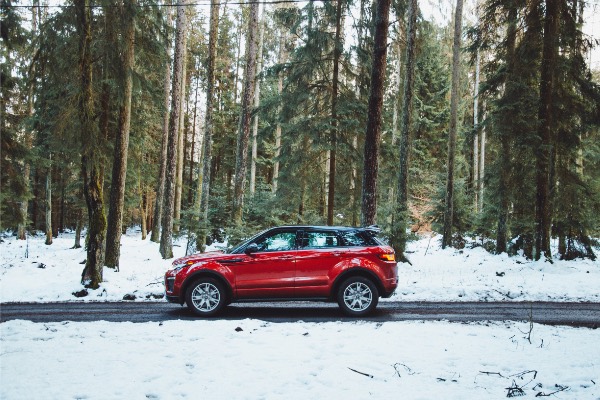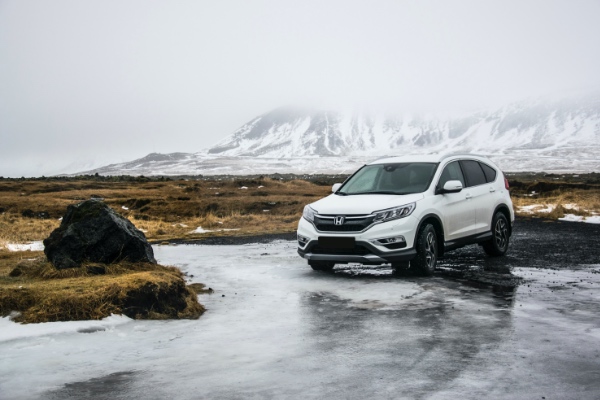March 03, 2021
Winter tires from O to O

Overview
When should you drive with winter tyres?
When should you drive with winter tyres? The well-known rule of thumb and common mnemonic puts it in a nutshell: from O to E - that is, roughly from October to Easter. But why actually? Changing tyres costs money and doesn't always seem to make sense. After all, it doesn't snow and freeze during the entire period, and certainly not everywhere.
Nevertheless, it is urgently advisable to drive with winter tyres from O to E. The reasons are:
• Safety
• Legal situation
• Insurance
But let's take a closer look.

Summer tyres in winter?
We traditionally associate winter with ice and snow, and you may be driving in regions where such weather conditions are not (or no longer) to be expected. But even in bone-dry weather, summer tyres are potentially a safety hazard when it's cold.
This is because they were developed specifically for warmer temperatures. This is particularly evident in the rubber compound: summer tyres contain less natural rubber than winter tyres and are therefore inherently harder.
This is good in warm weather: it helps to keep rolling resistance relatively low, which has a favourable effect on fuel consumption, among other things. In cold weather, on the other hand, it can be dangerous. Hard tyres on cold roads mean a greater risk of slipping. The fact that summer tyres harden even more at 7 degrees Celsius increases this effect.
What the Road Traffic Regulations say
In Germany, winter tyres have been compulsory by law since 2010. This is not bound to a fixed period of time. It comes into effect in certain weather conditions. The legislator defines these as follows: "Black ice, slippery snow, slush, ice and frost".
Conversely, this means: If the weather permits, you can drive with summer tyres in January without worrying. However, in Central Europe there is always the possibility of getting into some form of wintry weather between October and Easter. And by then at the latest, the appropriate tyres must have been fitted. That's what §2 paragraph 3a of the Road Traffic Regulations stipulates.
Since 2018, suitable tyres in Germany can be recognised by the Alpine symbol. Older tyres with the M+S symbol have a transitional period until 30 September 2024.
Non-compliance may result in penalties, as specified in the German catalogue of fines. Driving with summer tyres in winter weather is punishable by 60 euros and a point in Flensburg. If this is accompanied by an obstruction of traffic, the fine is 80 euros and one point. In the case of endangerment, it's 100 euros and a point.
The legal situation is therefore clear. But it is also clear that it will not always be possible to avoid driving on summer tyres between October and Easter. That's not ideal, but it's not a drama either. In this case, inform yourself thoroughly about the expected weather conditions and, if possible, drive in daylight to keep the risk low.

What makes winter tyres special?
What are the special characteristics of winter tyres? Firstly, there is the higher proportion of rubber, which makes them softer. This means they retain their suppleness even at temperatures below 7 degrees.
Another important factor is the tread: the wide, deep grooves are designed to absorb snow, which provides improved grip on snow-covered ground. A multitude of tiny sipes on the surface results in more grip - even on icy roads.
Winter tyres are therefore perfect for ice, snow and slush. In summer, however, their strengths turn into disadvantages: Among other things, softness and structure cause increased rolling resistance compared to summer tyres.
This in turn significantly increases fuel consumption. The softness of the tyres also leads to spongy handling - the vehicle is less securely on track and the braking distance is longer. On winter tyres all year round: also far from ideal.
Accidents and insurance
The first half of 2020 was turbulent overall, but there is also positive news: According to the Federal Statistical Office, there have never been fewer road accidents with fatalities and injuries in Germany since the fall of communism than in the first six months of this year.
Nevertheless, traffic accidents are still an everyday occurrence. Another argument for changing your tyres seasonally: If you drive in wintry weather with summer tyres and have an accident, this is considered "gross negligence". Your insurer now has the right to reduce your insurance benefit or even cancel it altogether (unless your policy covers gross negligence).
In addition, the victim of the accident bears a share of the responsibility in such cases.
All-season tyres - a good compromise?
Due to the high demand, many tyre manufacturers now offer all-weather or all-season tyres. These are characterised by a rubber compound that meets the minimum requirements for winter tyres, but also enables safe driving in summer.
Especially in regions without extreme weather, you may be well served with all-weather tyres. However, you should bear two things in mind. First, because the tyres are exposed to high temperature fluctuations, they wear out faster than the summer/winter tyre combination. If you want to save money, this factor is obviously part of the calculation.
And secondly, in some European countries winter tyres are absolutely compulsory. There, you are not allowed to drive with all-weather tyres during the cold season.

Conclusion
Driving with summer tyres all year round is not an option - this is already prohibited by the winter tyre obligation. On the other hand, winter tyres are a source of danger in the warm season.
The alternative to changing tyres is all-weather/all-season tyres. These are permitted and, according to consensus, are improving all the time.
But all-season tyres are still a compromise as of today. If you want to be on the road with maximum safety, the best solution is: winter tyres from October to Easter and summer tyres the rest of the time.

